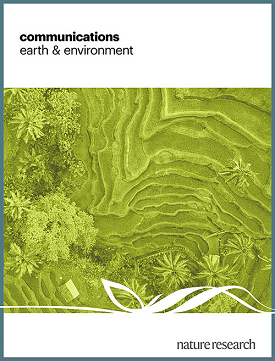Airborne observations of fast-evolving ocean submesoscale turbulence
IF 8.1
1区 地球科学
Q1 ENVIRONMENTAL SCIENCES
引用次数: 0
Abstract
Ocean images collected by astronauts onboard the Apollo spacecraft more than 50 years ago revealed a large number of ocean eddies, with a size between 1 and 20 km. Since then, satellite infrared, ocean color, sun glitter and synthetic aperture radar images, with high spatial resolution, have confirmed the ubiquitous presence of these small eddies in all oceans. However, observing the dynamical characteristics and evolution of these eddies has remained challenging. An experiment was recently carried out in the California Current system using the new airborne Doppler Scatterometer (National Aeronautics and Space Administration-Jet Propulsion Laboratory DopplerScatt) instrument that observes surface velocities. Here, with DopplerScatt, we mapped a 30 × 100 km domain over multiple days to unveil numerous 1–20 km ocean eddies, called submesoscale eddies, that evolve over a period of a few hours. The strong interactions between eddies generate horizontal velocity divergence, implying vertical velocities reaching 250 m day−1 at 40 m depth. The velocity field also produces horizontal dispersion of particles over a distance of 50 km within 12 h, which rapidly fills the turbulent eddy field. These observations suggest that submesoscale ocean turbulence may profoundly affect the vertical transport of heat, carbon, and important climatic gases between the atmosphere and the ocean interior, as well as the horizontal dispersion of tracers and particles. As such, submesoscale ocean eddies are a critical element of Earth’s climate system. Submesoscale eddies in the upper ocean play a critical role in the vertical transport and dispersion of ocean properties, including heat, nutrients, and carbon, making them essential for regulating the Earth’s climate system, according to results from the new airborne Doppler Scatterometer.

快速演变的海洋亚中尺度湍流的航空观测
50多年前阿波罗飞船上的宇航员收集的海洋图像显示了大量的海洋漩涡,大小在1到20公里之间。从那以后,卫星红外、海洋颜色、太阳闪光和高空间分辨率的合成孔径雷达图像证实了这些小漩涡在所有海洋中无处不在。然而,观察这些涡流的动力学特征和演变仍然具有挑战性。最近在加利福尼亚电流系统中进行了一项实验,使用了新的机载多普勒散射仪(美国国家航空航天局-喷气推进实验室多普勒散射仪)来观察表面速度。在这里,我们用DopplerScatt绘制了一个30 × 100公里的区域,历时数天,揭示了许多1-20公里的海洋涡旋,称为亚中尺度涡旋,它们在几小时内演变。涡旋之间的强相互作用产生水平速度辐散,这意味着在40米深度的垂直速度达到250米/天。速度场还会在12小时内产生50公里范围内的粒子水平弥散,迅速填满湍流涡旋场。这些观测结果表明,亚中尺度海洋湍流可能深刻地影响大气和海洋内部之间的热、碳和重要气候气体的垂直输送,以及示踪剂和粒子的水平扩散。因此,亚中尺度海洋涡旋是地球气候系统的一个关键因素。根据新的机载多普勒散射仪的结果,上层海洋的亚中尺度涡旋在海洋特性(包括热量、营养物质和碳)的垂直运输和分散中起着至关重要的作用,使它们对调节地球气候系统至关重要。
本文章由计算机程序翻译,如有差异,请以英文原文为准。
求助全文
约1分钟内获得全文
求助全文
来源期刊

Communications Earth & Environment
Earth and Planetary Sciences-General Earth and Planetary Sciences
CiteScore
8.60
自引率
2.50%
发文量
269
审稿时长
26 weeks
期刊介绍:
Communications Earth & Environment is an open access journal from Nature Portfolio publishing high-quality research, reviews and commentary in all areas of the Earth, environmental and planetary sciences. Research papers published by the journal represent significant advances that bring new insight to a specialized area in Earth science, planetary science or environmental science.
Communications Earth & Environment has a 2-year impact factor of 7.9 (2022 Journal Citation Reports®). Articles published in the journal in 2022 were downloaded 1,412,858 times. Median time from submission to the first editorial decision is 8 days.
 求助内容:
求助内容: 应助结果提醒方式:
应助结果提醒方式:


